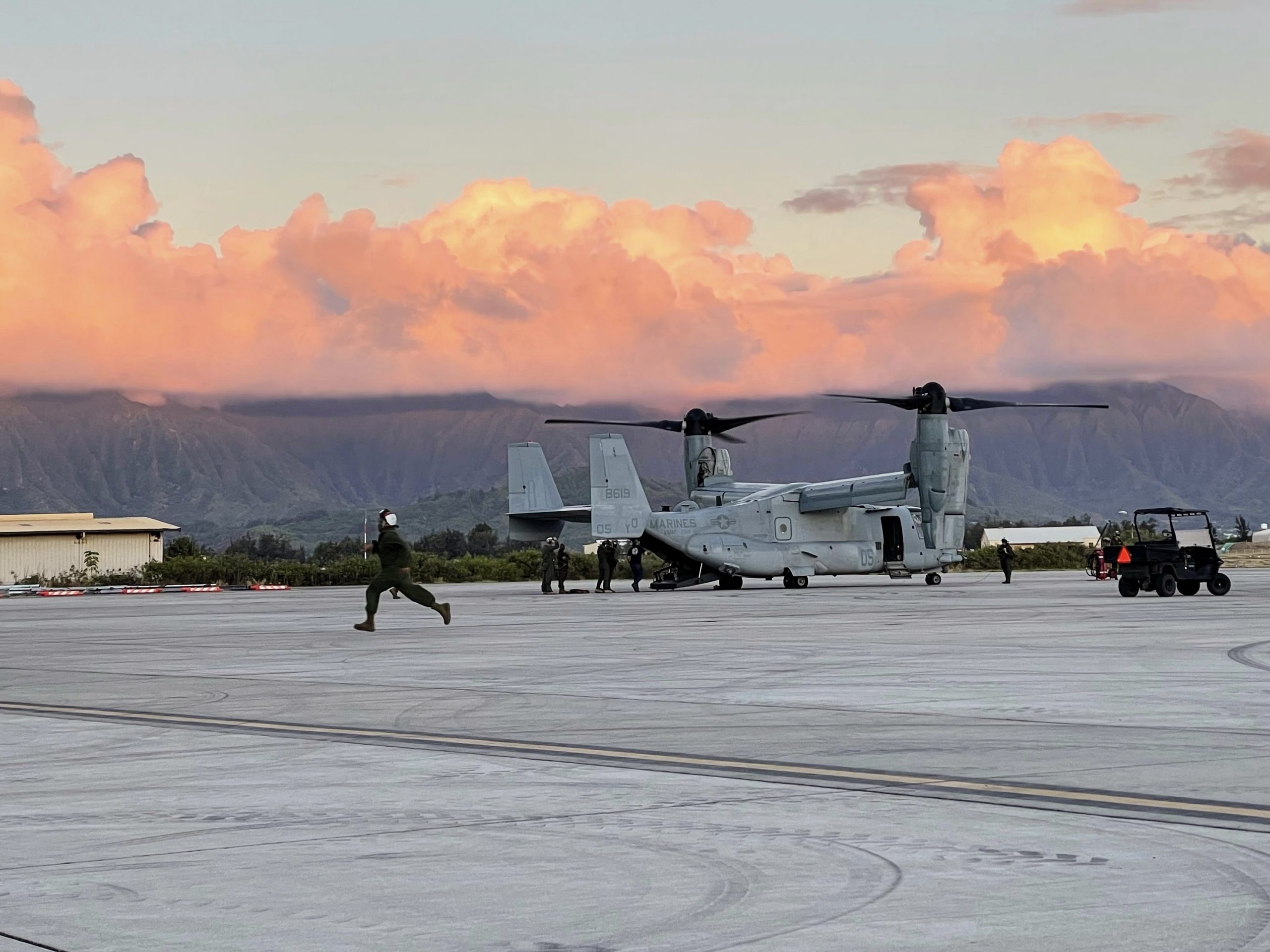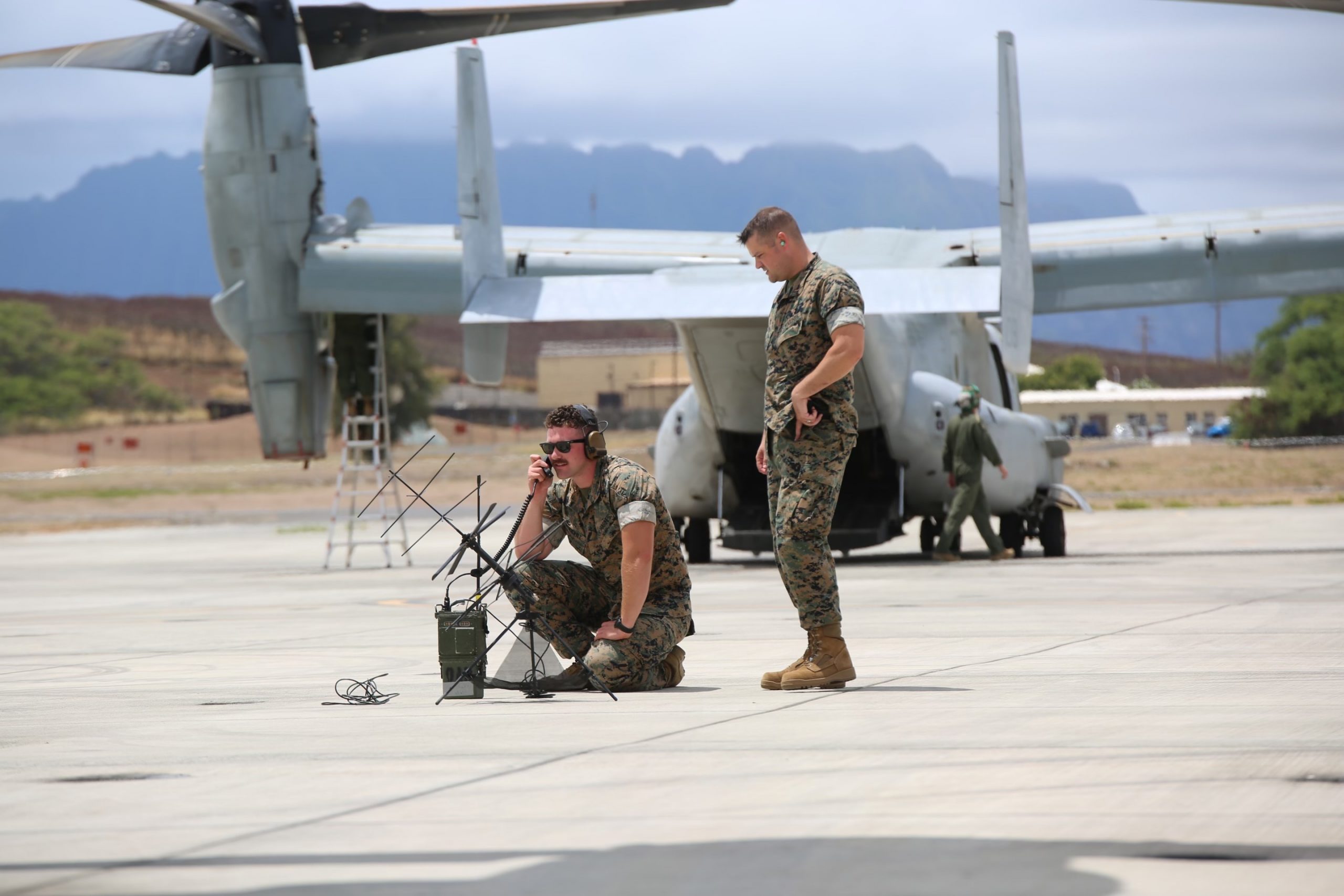By Matt Gonzales
MARINE CORPS BASE HAWAII
In August, Marine Corps Systems Command led one of the largest command and control user evaluations since the start of the COVID-19 pandemic.
MCSC collaborated with the Marine Corps Warfighting Lab, Marine Corps Forces, Pacific, Navy and Coast Guard to execute Island Marauder 21. The exercise, spread across multiple training sites on Oahu, enabled nearly 500 Marines to assess communication equipment in a maritime environment and provide direct feedback to system developers.
“Island Marauder allows Marines to employ, ask questions about and develop a greater understanding of their command and control equipment to better prepare them for the future fight,” said Maj. Ben Gardner, MCSC’s lead for Island Marauder 21.
The purpose of Island Marauder 21 was to employ a representative Littoral Combat Team to execute objectives using existing and emerging technologies under conditions anticipated for expeditionary advanced base operations, a core concept found in the Marine Corps’ Force Design 2030.
The event was a component of Large Scale Exercise 21—a live, scenario-driven exercise designed to better prepare the armed forces for combat in the Indo-Pacific region. LSE 21 is the largest exercise of this scale conducted by the U.S. in more than 50 years.
LSE 21 is also the first naval and amphibious large-scale exercise conducted since the Ocean Venture NATO exercises held during the Cold War. More than 25,000 Marines, Sailors and civilians took part in this multifaceted event.
Island Marauder serves as a critical LSE 21 exercise for the Marine Corps. The lessons learned through the event will inform future Marine Corps operating requirements and system development and acquisition tasks.
The Marine Corps is undergoing modernization efforts to support the future Marine. Gardner said supporting the Naval Expeditionary Force serves as a critical pillar in the Corps’ ongoing mission to prepare for the future fight against evolving threats.
“Island Marauder represents an integral step toward realizing this vision,” said Gardner.
Testing interoperability
This year’s Island Marauder was unlike previous iterations. In the past, MCSC provided experimental systems for participating Marines to use during training exercises. This year, MCSC instead integrated established programs of record in order to operate on live networks and fully integrate with the Navy.
The command provided systems to 3rd Marine Regiment; 1st Battalion, 12th Marines; 1st Battalion, 3rd Marines; and Marine Medium Tiltrotor Squadron 268. These capabilities included tactical tablets such as Marine Air-Ground Common Handheld and Target Handoff System version 2, a Very Small Aperture Terminal satellite capability and more.
“The intent was for Marines to use the equipment in a manner that best supports their operations,” said Gardner.
Third Marine Regiment is an infantry unit, based out of Marine Corps Base Hawaii, who will soon transition to the newly formed Marine Littoral Regiment—a stand-alone, naval force capable of enabling maneuver and operations in a maritime environment.
Once established, 3rd MLR will be the first of its kind in the Marine Corps.
“An objective of Island Marauder is to give [III Marine Regiment] a chance to use this equipment to better inform their process and shape how they’re going to structure themselves to become Marine Littoral Regiment,” said Maj. David Parker, communication officer at III Marine Regiment.
During Island Marauder, Marines were instructed to use gear as they would in a live, operational environment. MCSC devised scenarios incorporating various training objectives that mirrored the future Indo-Pacific battlefield, allowing participants to grow more comfortable with the systems and situations.
For example, one exercise saw participants seize terrain to enable artillery units to gain fire superiority on a distant island chain. The Marines of VMM-268 transported 3rd Marines and their equipment in an MV-22 Osprey from a pickup zone to a nearby island. Marines traveled in an Osprey equipped with a Networking On-the-Move system for an airborne command and control exercise.
Networking On-the-Move, a critical Force Design capability, was also integrated into a prototype Utility Task Vehicle and wheeled onto another MV-22 aircraft, showcasing its mobility and transportability. NOTM is a satellite command and control system Marines can leverage to communicate while mobile on the battlefield.
“This was the first time 3rd Marines have used NOTM on an aircraft,” said Gardner. “The task proved successful.”
During Island Marauder, MCSC integrated their communication equipment with LINK-16, a standardized communications system used by the U.S. and allied militaries. These capabilities helped to test interoperability among the joint forces in a denied or degraded environment.
The event also included ship-to-shore movements involving an amphibious transport dock, or landing platform dock, and a Landing Craft Air Cushion provided by the Navy. The LPD moved a group of Marines and Sailors from Oahu to Kauai via the LCACs.
“We integrated our equipment with naval and joint [command, control, communications, computers, combat systems and intelligence] systems in a realistic setting,” said Gardner. “That doesn’t happen often.”
‘An Invaluable Opportunity’
Routine interactions between infantry Marines and MCSC engineers is also uncommon.
Andrew Mitchell, a Naval Information Warfare Center Atlantic employee supporting MCSC as the lead engineer for Island Marauder, said Marines were eager to learn from the providers of their equipment, asking questions and receiving relevant, useful information.
These interactions also enabled MCSC program offices to consider the feedback and improve their equipment as needed.
“Having the diverse technologies we’ve brought to Island Marauder and putting them into a field user environment is valuable input to the development engineers,” said Mitchell. “This helps them further direct their work to give Marines better technology in the future.”
Marines participating in Island Marauder expressed their appreciation for the opportunity to familiarize themselves with critical systems, interact with engineers, and gain additional knowledge and skills needed to support future missions.
“I really appreciate the opportunity to gain firsthand experience and provide feedback to those organizations that have given us this equipment,” said Staff Sgt. Brandon Parker, a transmission chief with 1st Battalion, 3rd Marines. “It’s an invaluable opportunity.”
Maj. Christopher Montgomery, the VMM-268 aircraft maintenance officer, was one of the many VMM-268 Marines who provided support during Island Marauder. He believes strongly in the importance of large-scale testing events, as they foster experimentation and collaboration among the services.
“This exercise has given us the venue to test some of the capabilities, especially these new systems, and put them into practice as we achieve tactical objectives,” said Montgomery. “The support and integration of the industry representatives with the tactical level operators was effective.”
Island Marauder allowed MCSC to refine operational concepts that focus on fully integrating command and control capabilities across multiple domains. Commandant of the Marine Corps Gen. David Berger has emphasized the importance of defending key, contested maritime terrain to enable persistent sea denial and control operations to maintain a competitive advantage over enemy forces.
This article was published by Marine Corps Systems Command on September 1, 2021..
And an earlier article by Ashley Calingo highlighted the role of the exercise within the context of the wider U.S. Navy’s Large Scale Exercise 2021.
Marine Corps Base Hawaii—Marine Corps Systems Command provided support to exercise Island Marauder August 2-16 on Marine Corps Base Hawaii. Unlike previous years, Island Marauder this year was nested under the Navy’s Large Scale Exercise 21, a live, virtual and constructive, scenario-driven, globally-integrated exercise spanning 17 time zones.
During Island Marauder 21, a representative Littoral Combat Team executed objectives using existing and emerging technologies under conditions anticipated for expeditionary advanced base operations, a core concept found in the Marine Corps’ Force Design 2030. MCSC and the Marine Corps Warfighting Lab provided the technologies used and evaluated by Marines on the battlefield during the exercise.
“It’s critical we stay connected to our Marines and the operating forces to ensure the capabilities we’re providing not only meet their current needs, but will keep them ahead of any threat,” said MCSC Commander Brig. Gen. AJ Pasagian. “This is the perfect environment not only for us to solicit feedback on some of our new and emerging systems, but also assess the interoperability of those systems with our Naval partners.”
During the exercise, Marines used innovative communication equipment such as Networking On-the-Move, Marine Air-Ground Task Force Common Handheld, Target Handoff System Version 2 and more.
“We are taking fielded programs of record and providing this command and control equipment to 3rd Marine Regiment and a couple other units with whom they’re working,” said Maj. Ben Gardner, MCSC’s lead for Island Marauder 2021.
MCSC designed a series of scenarios designed to mirror real-life battlefield situations. For example, Marines will be loading a prototype NOTM system via Utility Task Vehicle onto an MV-22 Osprey from an airfield to a beach to test the equipment’s effectiveness while mobile.
The event allows the 3rd Marine Regiment, based in Hawaii, to familiarize themselves with a system they will be using in the future.
“This is the first time [3rd Marines] have used NOTM on an aircraft,” said Gardner.
MCSC collaborated with the Navy and Coast Guard to execute Island Marauder 2021. The Coast Guard provided a commissioned vessel to test interoperability among Marine Corps and Naval capabilities, a unique aspect of the exercise, said Gardner.
Island Marauder 2021 supports Commandant of the Marine Corps Gen. David Berger’s intention of developing a more naval force and better prepare for the expeditionary advanced base operations and the future Marine Littoral Regiment.
The Mission Brief of Island Marauder 2019 can be viewed below:
For an exercise by 2nd MAW last year which featured NOTM operating from an Osprey, see below:
Exercise Deep Water: Working the Integrated Distributed Insertion Force





